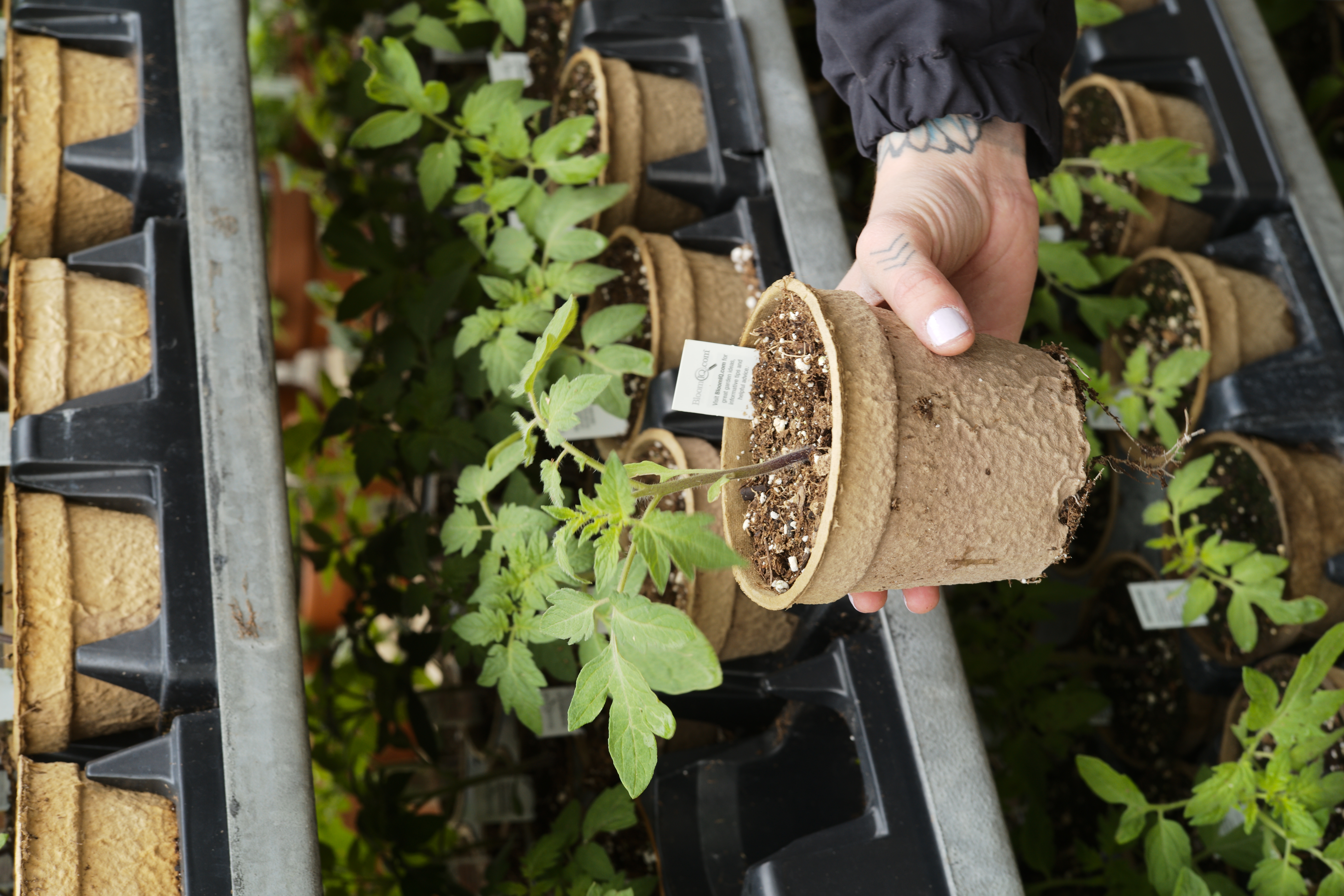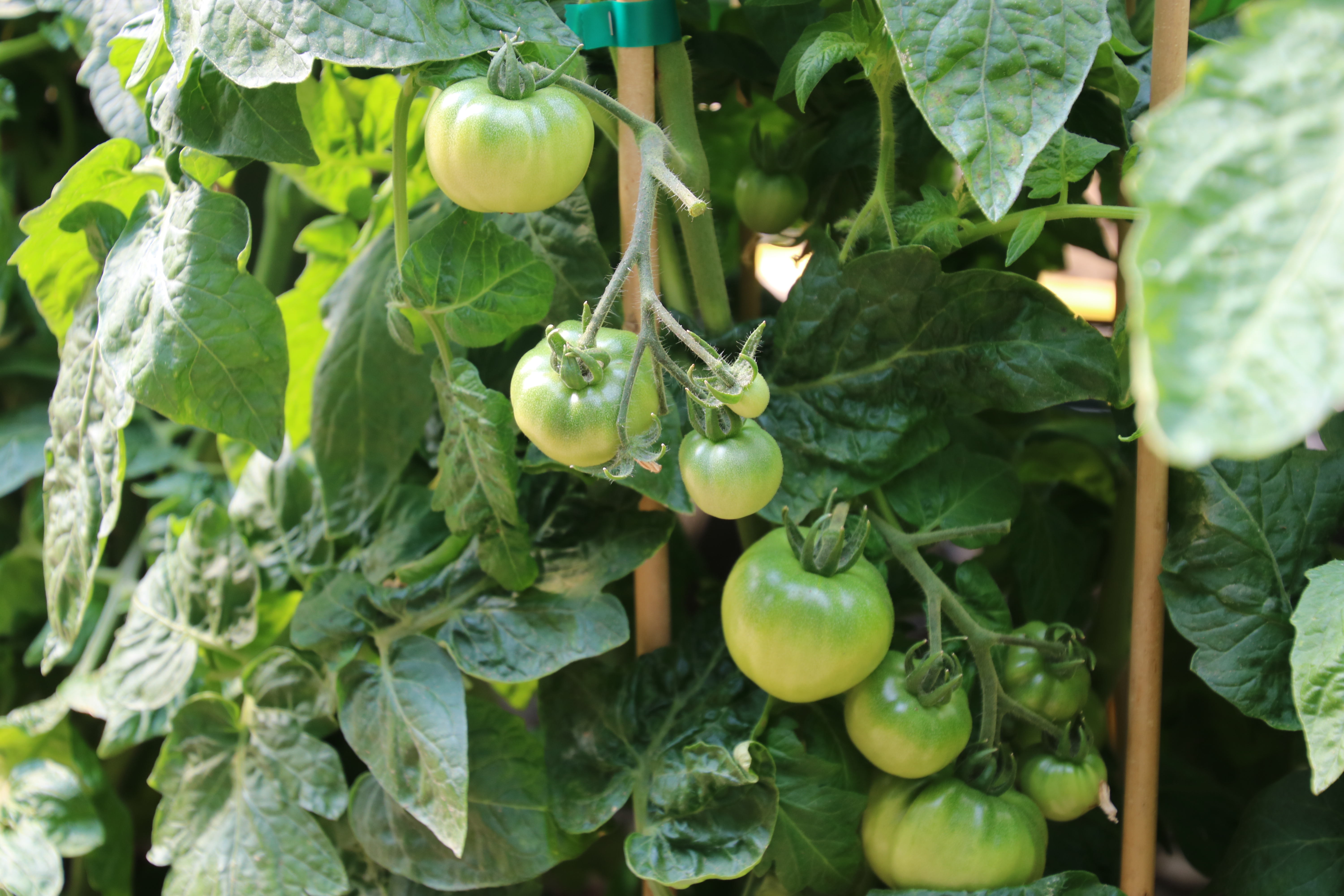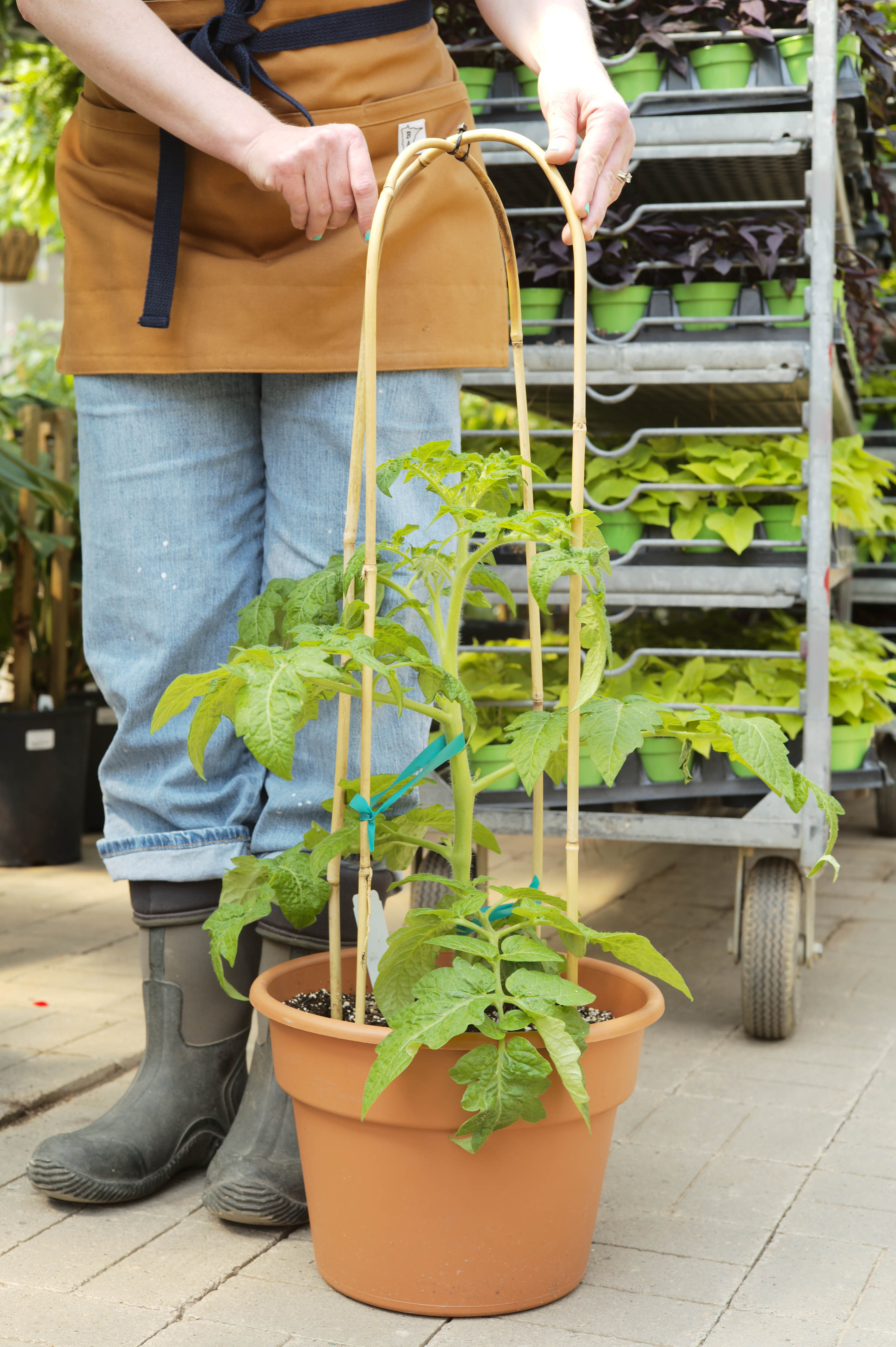Tomatoes Deep Dive
Posted by Jessie Jacobson on May 21st 2021
Did you know there are over 10,000 varieties of tomatoes? With all colors of the rainbow - purple, yellow, orange, red, and even orange, you are sure to find one that suits your tastes. Choose your shape and choose your size - round, oval, pear shaped, cherry sized, golf ball sized, softball sized, and so on! Eat them right of the vine, slice them for sandwiches and BLT’s, toss them in salads, cook them into sauces or squeeze them for juice. Pureed, dried, or pickled, tomatoes are delicious and packed with health power.
Health Benefits: Tomatoes have vitamins C, A, B1 (Thiamin), B2 (Riboflavin), B3 (Niacin), B5 (Pantothenic Acid), B6 (Pyridoxine), B9 (Folate), K, and E, and many minerals essential for good health plus beta-carotene and the pigment lycopene, super anti-oxidants that help prevent cell damage by free radicals. These phytonutrients work in synergy with other vitamins and minerals in tomatoes to promote heart and bone health and protect against inflammation and a number of different cancers.

Fun Facts.
Eating cooked tomatoes may act as a kind of internal sunscreen, according to researchers at the Universities of Manchester and Newcastle, England, by helping block UV rays. But eating tomatoes is only a supplement to using sunscreens, not a replacement.
Botanically speaking, a tomato is a fruit. The government classified it as a vegetable in the late 1800s so it could be taxed under custom regulations.
According to the USDA, Americans eat 22-24 pounds of tomatoes per person, per year. About half of that comes in the form of ketchup and tomato sauce.
A whopping 93% of American gardeners grow tomatoes in their yards.
China is the number one producer of tomatoes around the world. The U.S. is second.
It’s thought that tomatoes originated in Peru, where their Aztec name meant, “plump thing with a navel.”
The world’s largest tomato plant was grown in the experimental greenhouse at Walt Disney World. It produced over 32,000 tomatoes the first 16 months after it was planted.
Tomato (Solanum lycopersicum) plants can be divided into two groups: Indeterminate plants and Determinate plants.Definition time!
- Indeterminate varieties produce tall plants with rambling vines, so they need to be staked or braced with a tomato cage to hold the plant off the ground. They flower and produce fruit more gradually over a longer period during the season.
- Determinate varieties will typically grow to 3 to 5 feet tall, then stop. Though the do not grow as tall as their indeterminate counterparts, they still benefit from staking or caging to increase air flow, prevent disease, and support heavy fruit. Determinate varieties flower and fruit during a determinate amount of time – about 3-4 weeks. Because of the heavy onset of fruit, this makes determinate tomatoes a great choice for canning and preserving. If you’re short on space, determinate varieties are the best choice for container gardening.

We grow many tomato varieties at Tonkadale – both tried and true and some more off the beaten path. Some of our favorites include Cherokee Purple, Black from Tula and Mortgage Lifter.Sungold, Sunsugar and Supersweet 100 cherry tomatoes make a great snack – they’re so good they might not make it from the garden to the kitchen.
Regardless of which tomatoes you choose, there are some basic care principles to follow ensure the best chance for happy, productive tomato plants. Rotating the position of the vegetables in your garden each year helps to ensure that soilborne diseases and pests don’t take hold and become an issue from season to season. Plant tomatoes in a soil amended with composted manure or activated compost. When you choose your tomato plants, for the tall and quirky ones. At planting time, pull away the bottom leaves and bury the stem. This ensures a great root system and a sturdy plant. Amend with Tomato Tone to fertilize and add needed calcium to your plants. Make sure to plan on staking your tomato. It’s easiest to place your tomato cage over your plants at the time of planting. If you’re using a tomato cage, put it over the plant right away when the plant is young. As your tomatoes grow, prune away leaves that are near or touching the ground to precent soil borne disease. Pinch suckers as your plant develops to promote more fruit development. Maintaining a regular watering schedule. Water deeply, about 1” per week and never water over the foliage. Wet leaves are the perfect environment for fungal diseases to develop. Fertilize ever two weeks with Tomato Tone and you are all set until harvest.
Being a proactive gardener is a great way to avoid common tomato disorders that can rear their ugly heads as the season wears on. Here are some signs of things to look for that would indicate a problem:
Disorders:
Abiotic disorders distort plants and blemish fruits, but they are not caused by a living pathogen--usually a result of cultural practices or environmental conditions.
Physiologic leaf roll
- Leaf margins roll upward until they touch or overlap in a tube-like fashion.
- Usually result of hot dry weather or too much water, can also be caused by stresses to plant such as over pruning or fast growth
- Does not usually affect continued plant growth or yield
Blossom-end rot
- Affected fruit have a tan to black flattened spot at the blossom end of the fruit
- Caused by a calcium deficiency in the tomato plant
- Do not over apply fertilizer containing Nitrogen as this adds to the problem
- Heavy rain or draught conditions can add to the problem
- Calcium and consistent moisture should help
Sunscald
- A pale yellow to white spot on the side of the fruit facing the sun-surface may dry out
- Caused by leaf loss or over pruning exposing fruit to the sun
- Avoid sunscald by maintaining a healthy plant
Catface
- Malformation and scarring of fruit
- Causes are not known
- Large fruited varieties are more susceptible

Diseases:
Early Blight
- Brown lesions first appear on older, lower leaves then spread up the plant
- Leaf tissue turns chlorotic (yellow), then necrotic (brown), then falls off
- Fungus lives in the soil and on weedy solanaceous hosts
- Garden areas should be rotated and apply mulch to minimize disease
- Fungicide spray may be effective if applied preventatively (Tomato and Veggie 3 in 1)
Late Blight
- Responsible for the Irish Potato Famine of the 1840’s
- Leaves have large dark brown blotches with grey edge
- As it progresses there are large patches of dry brown foliage
- Spreads quickly
- Fungicides may be effective, check the website below for spore counts in your area
- http://newa.cornell.edu/index.php?page=tomato-diseases-tomcast
Anthracnose
- Small, depressed lesions that are circular in shape and sunken, often looking like bruising or molding on the fruit.
- The pathogen overwinters on infected plant debris.
- Staking and mulching helps
- Copper fungicides are effective when this a reoccurring problem.
Bacterial Canker
- A new disease in Minnesota
- Results in leaf discoloration, wilt, fruit spots, stem cracking and discoloration on tomato fruits
- Fruits have small, creamy, white spots with tan or brown centers
- Spreads by splashing water and dirty tools
- Infected plants should be disposed of and do not plant vegetables in the Solanaceae family in the same location for 3 years. Disinfect tools, cages, and toss wooden stakes.
Septoria Leaf Spot
- Sometimes mistaken for early blight, but can be treated similarly.
- Attacks at any point in the season, but is the most common in humid weather or after heavy periods of rain.
- Lower leaves show symptoms first.
- Round, yellow or water-soaked spots appear on the undersides of leaves. They quickly emerge on tops of leaves and turn to black or brown with tiny black dots in the center.
- Heavily infected leaves turn completely yellow, then brown, and fall.
- Septoria leaf spot does not display characteristic “target” or concentric spots seen in early blight.
- Fruit is rarely infected.
Powdery Mildew
First evident as pale-yellow leaf spots, then white powdery spots can form on both upper and lower leaf surfaces.
Powdery mildew infections are most common with humid conditions and temperatures around 68-81F.
Risky conditions include densely planted vines, plants crowded by weeds, plants in shaded sites, and over fertilized plants.
Apply a fungicide such as Revitalize or when a single spot of powdery mildew is first found or apply sulfur dust or spray to both the upper and lower surface of the leaves.
You can view images of each Tomato disorder and disease through the University of Minnesota Extension's website here.
Your best defense against diseases in tomatoes is prevention. We will show you the way:
- Remove and destroy infected leaves (be sure to wash your hands afterwards).
- Once blight is present and progresses, it becomes more resistant to fungicide treatments. Treat as soon as possible and on a schedule as directed by the label
- Rotate crops. Diseases can overwinter in soil and strike again the following season. Diseases that affect tomatoes do not affect non-Solanaceous crops which includes potatoes, eggplant, and peppers.
- Clean up garden debris at the end of each season. Some diseases can survive in garden debris for up to three years.
- Plant tomatoes in a raised bed to improve drainage and prevent diseases from spreading.
- Choose strong hybrid varieties to increase chances of plants remaining disease-free during the season.
- Give tomato plants extra space (more than 24 inches) to let air to move and keep leaves dry.
- Water the soil, not the foliage to prevent water splashing which can spread soil borne disease. Avoid overhead watering.
- Stake tomato plants for better circulation.
- Mulch with black plastic or landscape fabric to prevent fungal infections from spreading from the soil to leave.
- Remove and destroy affected plants at the end of the season.
- Provide good air movement around plants through proper spacing, staking of plants and weed control.
WOWZA that was a lot of information. But not to fret, with time, patience, practice you will become the tomato grower you were meant to be. As always, send us your questions, bring in a leaf sample, or send us a photo of your tomato plants. We are obsessed with your tomato growing success!

